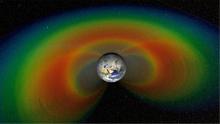This artist's concept shows a cutaway view of the Van Allen radiation belts, which are wide zones that trap charged particles from the Sun. The particles can damage spacecraft or people that transit the belts, so scientists study them carefully to more accurately assess the hazard. [NASA/GSFC/Scientific Visualization Studio]
You are here
Van Allen Belts
The first discovery of the Space Age was two intense radiation belts that encircle Earth. They’re called the Van Allen Belts in honor of James Van Allen, the scientist who led the team that found them. And scientists are still learning about them today.
The belts contain charged particles that are trapped by Earth’s magnetic field. Some of the particles come from the solar wind. Others are created by interactions between cosmic rays and Earth’s atmosphere.
The inner belt stretches from altitudes of a few hundred to a few thousand miles. The outer belt extends far beyond that. Most of the time, there’s a gap of a few thousand miles between them.
But a few years ago, a pair of probes — also named for Van Allen — found that the belts are dynamic. They expand, contract, and vibrate in response to storms on the Sun. At times, the gap between them can fill in, creating a single super-belt. The inner belt can expand to within just a couple of hundred miles of Earth’s surface. And the mixture of particles in the belts can change.
Understanding the belts is important for space flight. Most satellites generally stay below the belts. But any craft that spends much time in the belts gets zapped with a hefty dose of radiation — enough to fry unprotected systems. So spacecraft operators need to know what to expect from the belts so they can shield their hardware — from one of the many hazards of space flight.
Script by Damond Benningfield
Get Premium Audio
Listen to today's episode of StarDate on the web the same day it airs in high-quality streaming audio without any extra ads or announcements. Choose a $8 one-month pass, or listen every day for a year for just $30.






